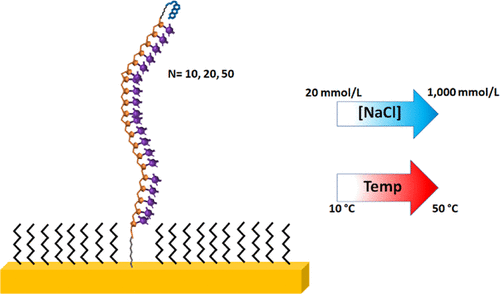Our official English website, www.x-mol.net, welcomes your
feedback! (Note: you will need to create a separate account there.)
Conformational Changes of Immobilized Polythymine due to External Stressors Studied with Temperature-Controlled Electrochemical Microdevices
Langmuir ( IF 3.7 ) Pub Date : 2021-02-17 , DOI: 10.1021/acs.langmuir.0c03219 Ramya Vishnubhotla 1 , Christopher B Montgomery 1 , Kristen L Steffens 1 , Steve Semancik 1
Langmuir ( IF 3.7 ) Pub Date : 2021-02-17 , DOI: 10.1021/acs.langmuir.0c03219 Ramya Vishnubhotla 1 , Christopher B Montgomery 1 , Kristen L Steffens 1 , Steve Semancik 1
Affiliation

|
Conformational changes of single-stranded DNA (ssDNA) play an important role in a DNA strand’s ability to bind to target ligands. A variety of factors can influence conformation, including temperature, ionic strength, pH, buffer cation valency, strand length, and sequence. To better understand the effects of these factors on immobilized DNA structures, we employ temperature-controlled electrochemical microsensors to study the effects of salt concentration and temperature variation on the conformation and motion of polythymine (polyT) strands of varying lengths (10, 20, 50 nucleotides). PolyT strands were tethered to a gold working electrode at the proximal end through a thiol linker via covalent bonding between the Au electrode and sulfur link, which can tend to decompose between a temperature range of 60 and 90 °C. The strands were also modified with an electrochemically active methylene blue (MB) moiety at the distal end. Electron transfer (eT) was measured by square wave voltammetry (SWV) and used to infer information pertaining to the average distance between the MB and the working electrode. We observe changes in DNA flexibility due to varying ionic strength, while the effects of increased DNA thermal motion are tracked for elevated temperatures. This work elucidates the behavior of ssDNA in the presence of a phosphate-buffered saline at NaCl concentrations ranging from 20 to 1000 mmol/L through a temperature range of 10–50 °C in 1° increments, well below the decomposition temperature range. The results lay the groundwork for studies on more complex DNA strands in conjunction with different chemical and physical conditions.
中文翻译:

用温控电化学微器件研究外部应力源引起的固定化多胸腺嘧啶构象变化
单链 DNA (ssDNA) 的构象变化在 DNA 链与靶配体结合的能力中起重要作用。多种因素可以影响构象,包括温度、离子强度、pH、缓冲阳离子价、链长度和序列。为了更好地了解这些因素对固定化 DNA 结构的影响,我们采用温度控制的电化学微传感器来研究盐浓度和温度变化对不同长度的多胸腺嘧啶 (polyT) 链的构象和运动的影响 (10, 20, 50核苷酸)。PolyT 链通过硫醇接头通过金电极和硫键之间的共价键连接在近端的金工作电极上,在 60 到 90°C 的温度范围内可能会分解。这些链还在远端用电化学活性亚甲蓝 (MB) 部分进行了修饰。通过方波伏安法 (SWV) 测量电子转移 (eT) 并用于推断与 MB 和工作电极之间的平均距离有关的信息。我们观察到由于不同的离子强度而导致 DNA 柔韧性的变化,同时随着温度升高跟踪 DNA 热运动增加的影响。这项工作阐明了 ssDNA 在 NaCl 浓度范围为 20 至 1000 mmol/L 的磷酸盐缓冲盐水存在下的行为,温度范围为 10-50°C,增量为 1°,远低于分解温度范围。这些结果为结合不同化学和物理条件研究更复杂的 DNA 链奠定了基础。
更新日期:2021-03-02
中文翻译:

用温控电化学微器件研究外部应力源引起的固定化多胸腺嘧啶构象变化
单链 DNA (ssDNA) 的构象变化在 DNA 链与靶配体结合的能力中起重要作用。多种因素可以影响构象,包括温度、离子强度、pH、缓冲阳离子价、链长度和序列。为了更好地了解这些因素对固定化 DNA 结构的影响,我们采用温度控制的电化学微传感器来研究盐浓度和温度变化对不同长度的多胸腺嘧啶 (polyT) 链的构象和运动的影响 (10, 20, 50核苷酸)。PolyT 链通过硫醇接头通过金电极和硫键之间的共价键连接在近端的金工作电极上,在 60 到 90°C 的温度范围内可能会分解。这些链还在远端用电化学活性亚甲蓝 (MB) 部分进行了修饰。通过方波伏安法 (SWV) 测量电子转移 (eT) 并用于推断与 MB 和工作电极之间的平均距离有关的信息。我们观察到由于不同的离子强度而导致 DNA 柔韧性的变化,同时随着温度升高跟踪 DNA 热运动增加的影响。这项工作阐明了 ssDNA 在 NaCl 浓度范围为 20 至 1000 mmol/L 的磷酸盐缓冲盐水存在下的行为,温度范围为 10-50°C,增量为 1°,远低于分解温度范围。这些结果为结合不同化学和物理条件研究更复杂的 DNA 链奠定了基础。











































 京公网安备 11010802027423号
京公网安备 11010802027423号